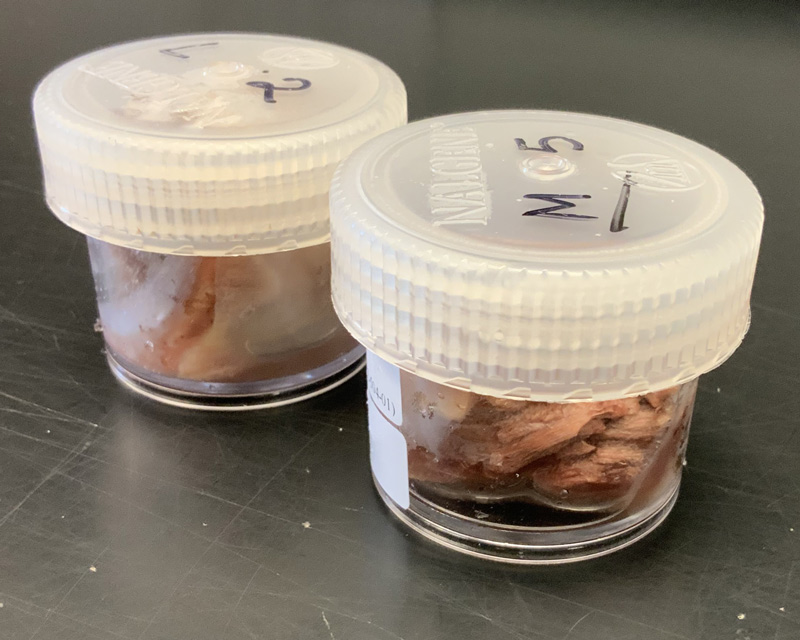Procedure for Collecting and Sending Biological Tissue Samples
These recommendations and procedures apply to the analytical tests performed by the Centre de toxicologie du Québec as part of research activities. They deal with the sampling and sending of biological tissues.
Preparation
The biological tissues sent to the CTQ as part of projects are of animal origin: whale fat, mollusk, eggs, fish flesh, kidney, liver, muscle, etc.
When collecting tissues, it is important to use the appropriate container, because some of them may be contaminated by the analytes that you want to measure.
The recommended container is:
- Other types of containers could be appropriate. Informez-vous from our advisors.
- In order to avoid contaminating your samples, be careful when handling the material and the samples. Wearing nitrile gloves protects you from infections and also allows to reduce the risk of contaminating the samples.
- The tightness of the container is essential for sending tissues.
Sampling
- The amount of samples to be taken is determined by the type of tissue and the quantitative analysis to be performed. Please obtain the information from our advisors.
- If an aliquot must be sent, please be careful when cutting. Use a scalpel previously washed with nitric acid 10%, and rinsed with demineralized water.
Storage
- In order to ensure the integrity of the samples of tissues in the short, medium and long term, it is recommended to freeze them at - 20oC. Dry ice will then be used during the transportation.
Preparing the shipment
Establish an exhaustive list
A list of samples included, on paper, must be joined to the shipment. Furthermore, the CTQ recommends to send a copy of this list by e-mail to the person responsible of projects at the CTQ ([email protected]).
This list must contain the following information:
- The identification of the samples;
- The dates of sampling and all other relevant information, such as the place of sampling, the type of sampling;
- The contact information of the applicant (address, mail, telephone, etc.).
Proper identifying of samples
Each sample must be identified with a self-adhesive label printed with a laser printer, in order to prevent the discolouring of the ink. The label must be resistant to freezing and biological liquids. A barcode identification should be the preferred option.
Choosing the right courier service
For the shipment of the samples, the CTQ recommends a fast, reliable courier service, that ensures a close tracking of the shipments and offers a proof of delivery (ex.: Federal Express, UPS, World Courier, etc.). The shipment of samples for reception the following day is usually difficult and expensive. Provided that all necessary precautions are taken (sufficient amount of refrigerant, etc.), and sending the shipment at the beginning of the week, the samples will arrive to destination in good condition. If the samples are to remain in circulation during the week-end, they must be kept frozen by the courier company.
Verify the requirements of cross-border customs
Carefully verify with the courier service all the requirements of the cross-border customs. The courier company is the best suited to inform you about the applicable laws in every country where the samples will transit through.
- In order to minimize the waiting time at customs, please ensure that you have an import permit (if required) and all other relevant documentation (ex.: zoo-sanitary certificate, etc.).
Shipping
A few days before the shipping, please send the shipment tracking number to the CTQ by e-mail, in order for the CTQ to be able to quickly take action, should an issue arise during transportation.
How to pack the samples
- Place the samples in order in the appropriate box, or simply in a plastic bag;
- Add sufficient absorbent paper;
- Close the box or the bag;
- Place everything inside a Ziploc-type bag;
- Place everything in a cooler;
- Add the dry ice in sufficient quantity to last the duration of the transport time;
- Fill the empty space with padding brown paper;
- Close the cooler and the cardboard box;
- Place the sender and receiver labels;
- Add the mention “EXEMPT ANIMAL SPECIMENS”;
- Add the dry ice labels;
- Add the commercial invoice for the shipping.
With dry ice inside, the cooler should not be tight, because that increases the risk of explosion.
How to identify the shipment or the cooler
- Place your address as the sender
- Place the receiver’s address:
Laboratoire de toxicologie, Centre de toxicologie / INSPQ
945 avenue Wolfe, 4e étage
Québec, QC, G1V 5B3
Canada
- In order to minimize the waiting time at customs, the CTQ recommends to add the following mention on the outside of the cooler: “EXEMPT ANIMAL SPECIMENS” or “EXEMPT HUMAN SPECIMENS”, and the mention “EXEMPT ANIMAL SPECIMENS, ANIMAL TISSUES, FOR RESEARCH ONLY, NO COMMERCIAL VALUE” on the commercial invoice.
Please watch our video about the packaging and sending of biological tissue samples (duration: 3 min 18 sec)


